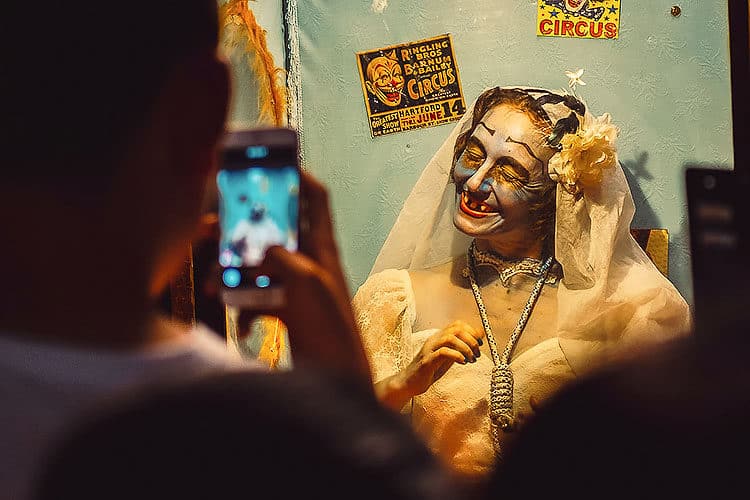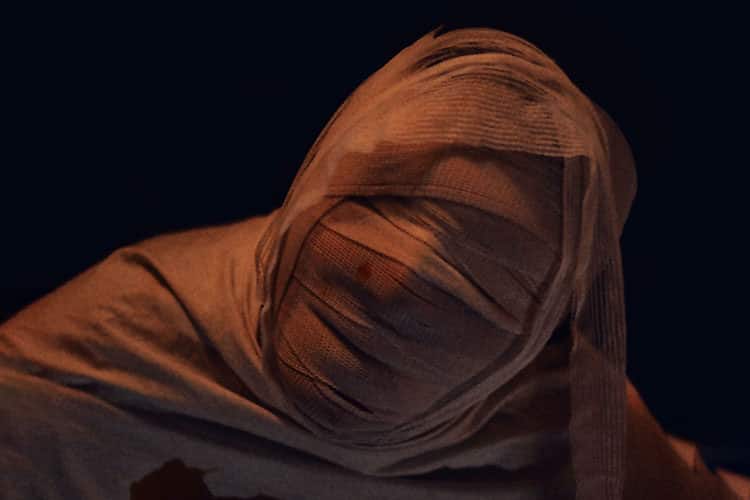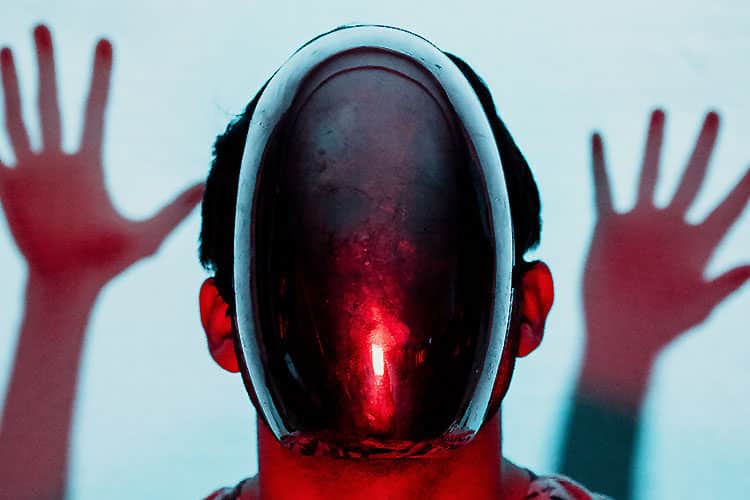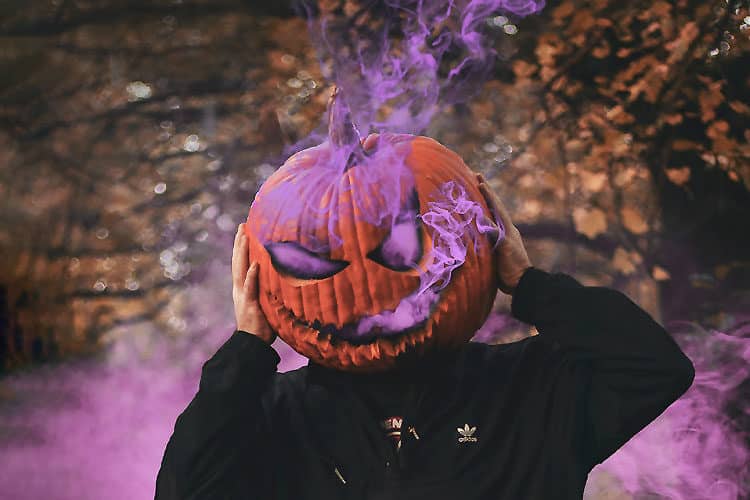Strategies from FearWorm Hauntvertising for how to market your attraction during a post-pandemic Halloween season
By HaunTopic Radio
When a global crisis happens, like COVID-19 and similar contagious pandemics, haunted attraction and entertainment venues can suffer. Customers can become fearful to attend close-quarters events like concerts and attractions. State regulations may be different for your event this year, and they’ll probably keep changing weekly, so you may be feeling a bit uncertain about what this year’s season will hold for you. This doesn’t mean you can’t open (unless your state says you can’t) or that you can’t provide the best and safest show ever. You’ll just need to do some extra planning and brainstorming.
How do you stretch your money for marketing and create a safe environment for your customers? You can be smart with your overall budget and still focus on your marketing plan. Highlighting your brand identity can show your customers that your event can be trusted. Getting creative with your advertising will help you make a bigger impact on your audience.
This blog is based on our May 26, 2020 HaunTopic podcast in which we talked with Tyler Barnett of FearWorm Hauntvertising about how to be successful with your marketing plan, stretch your budget, and keep your customers trusting your brand during these uncertain times.
Key Takeaways
- Expect your attendance numbers to be down this year. We must all run a leaner business this year.
- Whether we open this season isn’t the question. The question is whether people will want to go out. “I believe this 2020 season will hinge on the 17-to-26-year-olds. That’s my opinion based on the attitude Gen Z has about this right now.”
- Part of the strategy this year is a huge PR campaign in which each individual haunt states: “Here’s what we’re doing to keep people safe.”
- If a haunt does at least 25% of the business it did last year, it will have successful year this year. That’s a scary number, but we have to be realistic and plan to take that kind of hit.
- Use keywords like ‘safe,’ ‘we sanitize,’ ‘social distancing,’ or whatever in your marketing. However, this year or any year, marketing should highlight the guest experience.
- There needs to be a nightly sanitation regimen of going through the haunt and wiping everything down. Perception is reality, and if you’re coming off as an unsafe, unclean haunt, it’s going to be bad news for you.
- Social media should be the focus of marketing your haunt, and everything starts with your website.
- Take a weekend in August—if your haunt is opening sometime in September—to schedule social media posts. The goal by the end of the weekend is to have two or three posts a week scheduled all the way through the end of October.
- It’s relatively easy to build a successful brand when times are good, but, when times get chaotic, you have to double down on your brand and on your marketing and really go for it. However, it’s a perfect opportunity to capture market share from your competition.
- If you can’t open this year, support the haunts in your area and realize it’s going to be okay. You’ll come back stronger next year.
Listen to the Podcast
A Little About Tyler and FearWorm
Tyler has been working in the haunted attraction industry for about 15 years—basically, since he was a little kid dressed up as a goblin. He put on his first haunted house production when he was in high school, which was a fundraiser for the drama club. “We raised $7,000, which was three and a half years’ worth of budget that the drama club had, in one night,” he said.
In 2016, Tyler started working with FearWorm, and last year he was made partner in the agency. FearWorm is the first and largest haunted-attraction-specific marketing agency in the industry. “We try to continue innovating, and a big part of our mission is education. We put information out there as much as we can, and we hold seminars all the time. In the last few months, during this quarantine, we’ve tried to step up our game when it comes to education to help the industry be better, have better clients and better relationships, which happens when people in the industry are more informed about what’s going on in the marketing realm. Everybody seems to know what’s happening when it comes to masks, props, animatronics, lighting, and sound, but often marketing kind of falls under the radar. Our message is, ‘Hey, you don’t get to buy the mask or the props or build the haunt or do any of that without your marketing.”

Prepare for the Best. Expect the Worst.
Most of your customers want to return to their normal lives and go back to things that excite and entertain them, like your haunted house. However, some will be fearful of venturing out so soon. In many states, restrictions may continue to be in place that may affect how you operate your haunt. In most instances, attractions will have to take precautions to keep customers and staff safe. Expect your attendance numbers to be down this year and, if they’re not, you’ve done a great job at being prepared. In any case, you must run a leaner business this year.
We asked Tyler what haunts should be doing now during these COVID-19 times. He replied, “As a marketing agency, one of our jobs is to pay attention to trends. Right now, it’s really hard to say what’s happening or what to expect, because it seems like nobody truly knows what’s going on. You know, you can watch a few different news stations and get a few different stories. I tend to follow things like the CDC, the World Health Organization, and trusted people like my doctor and my mother, who’s the director of a hospital. In Kentucky, cases have been flat for about four weeks, and it seems like the general consensus amongst people is that they’re ready for this thing to be over. They’re ready to get out and do normal things again, despite the health hazards involved. States are opening up, but whether that’s premature is hard to say,” he said.
Tyler believes the Halloween season will open as planned. “But whether we open or not isn’t the question. To me, the question is whether people want to go out. Now, luckily for haunted houses, the vast majority of the haunted-house demographic are those same dumb teenagers we saw on the beaches in Florida that were just ignoring everything. So, they’re going to go, no matter what, because they think they’re invincible. The big question is whether younger kids, who rely on their parents for transportation and money to attend, will be able to, and whether families with parents in their 20s, 30s, and 40s will go. I believe this 2020 season will hinge on the 17-to-26-year-olds. That’s my opinion based on the attitude Gen Z has about this right now,” he said.
Tyler is concerned that some haunt owners won’t follow safety procedures and practice social distancing in a proper way, the local news and local government will be alerted, and every haunt in that market will get shut down. “Part of the strategy this year is a huge PR campaign that each individual haunt needs to start yesterday. This means contacting your local officials, your local news media, and put your plan out there: ‘Here’s what we’re doing to keep people safe.’ This sets the standard that all the other haunts have to rise to.”

Should a Haunt Advertise that It Wants Fewer People to Attend this Year?
Social distancing is going to require most haunts to allow fewer guests in. That’s just the reality. We asked Tyler how this can be a positive part of advertising. “That’s a tough one. Ideally, we don’t want fewer people, but if a haunt does at least 25% of the business it did last year, it will have successful year this year. That’s a scary number for a lot of people to try and swallow, but, we have to be realistic and plan to take that kind of hit. Does this mean budget’s gotta be cut by 75%? No, because that will kill your brand into next year. The main issue is the safety one. I think we should look to theme parks like Disney, Universal, and Six Flags for guidance about what to do and how to handle reopening and crowd control. Disney is opening at 50% or 25% capacity and plans to slowly ramp things up,” explained Tyler.
Other options to consider include instituting reservations, crowd control, virtual queueing, and timed ticketing. “Whatever decisions you make, include that in your marketing,” noted Tyler. “Use keywords like ‘safe,’ ‘we sanitize,’ ‘social distancing,’ or whatever in your marketing. However, having said that, my view on marketing—this year or any year—is to highlight the guest experience. It’s not, ‘We have this attraction and this attraction and this attraction.’ No one cares about that. Not a single customer. They just want to know, ‘Is it scary? Are we going to have fun? What does it cost?’ Your advertising should show people being scared. Your marketing should highlight the experience people have when they come to your haunt. That’s it. This year, you’re going to need new images, videos, website notices, social media strategy, social media campaigns, and keywords for Google,” he advised.

Another big consideration for haunts when it comes to guest safety is determining what to leave in and what should come out—for example, claustrophobic tunnels in which people touch fabric and other materials. We asked Tyler about his ideas on that, and he replied that nothing needs to be dispensed with, but certain things may need to go into storage for a while. “Every piece of fabric or cloth that hangs in your guests’ way has to come out. If you don’t have a way to completely shield someone’s face as they go through, all that has to come down—the bedsheets, the dead bodies, the claustrophobic tunnel, the burlap, the erosion cloth. These are porous materials that can hold this virus for up to two weeks, and they have to go,” he said.
In addition, there needs to be a nightly sanitation regimen of going through the haunt and wiping everything down. “Remember, perception is reality, and if you’re coming off as an unsafe, unclean haunt, it’s going to be bad news for you.”
The same goes for staff. We need to keep costumes separate and sanitize every night. We need to keep our actors safe so they keep our customers safe.
Tyler chimed in that he feels this may not be the year for actors. “I hate to say this, because I love actors, but this may be the year to load up on animatronics. The liability now with live actors is too great right now.” One way to do this is to have animatronics feed the scare and keep the actors back as a distraction.
This is going to be a year when we’re testing things and pushing the extremes, said Tyler. “This means we can be more creative than ever before. Although I have concerns about how haunts are going to do this year, I’m also excited to see what creativity can come out of this.”

Where to Market Your Haunt
Tyler believes social media should be the focus of marketing your haunt, and everything starts with your website. “Do you have a COVID-19 coronavirus release statement on your website? Make sure you have that, and make it easy to find with a big button on your homepage. Social media should be the facade of your entire attraction, and information about your response to COVID-19 should be the first thing anyone sees, whether it’s on Instagram, Snapchat, TikTok, Facebook, YouTube, or whatever. TikTok is the big one right now. You’ll still be running videos and doing your usual marketing, but you’ll be including messaging to indicate that you’re taking the steps needed to keep your guests, actors, and staff safe,” he said.
Next, said Tyler, remarket to your previous guests, and include new messaging that’s just for them.
“There’s also OTT, which stands for ‘over the top.’ This is your Hulu, your Netflix, Disney plus, Twitch, and the Sci-Fi channel. You can run ads on those platforms, and there are usually one or two non-skippable ads throughout the program. You buy the ads per the thousand and, for $20 or $30, you can buy a thousand on targeted, specific networks. There are also other digital tactics you can use like capturing mobile IDs and geo-fencing.”
When it comes to social media, Tyler said the key is feeding the algorithm. “First, create great content that’s naturally engaging. The worst thing you can do on your social media account is just be salesy all the time. This isn’t feeding your page algorithm. Post things that will get people to engage with your content, generate conversations, and that aren’t meant to result in a sale. Put up one- or two-minute videos of something entertaining that’s related to your haunt. Think in terms of, ‘Here’s a nugget of amazing content. Enjoy it. We’ll see you later.’ That’s all.”
Tyler continued, “Billboards are still strong. From information on the billboard, people can look you up on social media and go to your website. Of course, if you’re out in the middle of nowhere, a billboard may not be effective, but, in a major metropolitan area, people see it on their way to work and it sticks in their mind. And here’s some advice: Don’t have more than about five words on the billboard. It should have some unnatural action that gets people’s attention, your logo, and your website. That’s it,” he said.

Fifteen- to 30-second radio ads are a good idea, said Tyler. “However, the secret sauce to any successful marketing campaign is frequency. With radio, it’s damn near impossible to get sufficient frequency. You have to figure out your buying strategy with radio, and work out deals with the station. See if you can get some bumpers going into and coming out of a commercial segment. Instead of buying a 30-second spot, buy two 15-second spots to bookend the commercial segment. I encourage you to opt for Spotify and Pandora instead of radio, because it’s a lot easier to get that frequency,” he advised.
In thinking about marketing, Tyler noted that people will see your ad on social media or a billboard or Instagram, and all of these are important touchpoints to get people to your website. “However, all this isn’t really going to matter until somebody is with their friends on a Friday night in October and recommends that they all go to a haunted house. Somebody might say, ‘I keep seeing this one on Facebook,’ and they go to Google and search ‘haunted house near me.’ Hopefully, your house is the top ad, and they click through to your website and buy tickets. At the end of the day, you can’t force somebody to buy a ticket. They’re either going to buy a ticket or they’re not, and it really comes down to whether your brand is strong enough to get that sale,” he said.
Tyler suggested taking a weekend in August—if your haunt is opening sometime in September—to schedule social media posts. “The goal by the end of the weekend is to have two or three posts a week scheduled all the way through the end of October. Get that done. Now, that doesn’t mean you never touch the schedule again. During the season, a bunch of fun things are likely to happen, so snap a photo, put it on social, snap a photo, put it on Instagram, and just keep it going.”
Tyler had an interesting take on marketing during difficult time. “You can gain market share in a crisis like this pandemic. Some of the biggest brands in the world right now such Coca-Cola and Proctor & Gamble were either started or grew during the Great Depression. It’s relatively easy to build a successful brand when times are good, but, when times get chaotic, you have to double down on your brand and on your marketing and really go for it. However, it’s a perfect opportunity to capture market share from your competition. We have a video about this on our website. Some haunts may feel it won’t be a good year, so they won’t spend on marketing. It’s a fact of business that you can’t save yourself into profitability. Only one thing grows profits, and that’s sales, and only one thing grow sales, and that’s marketing. So, put your money into your marketing with a focus on branding. Save money on your build and, I hate to say it, save money on your staff—in particular, your ancillary staff—parking lot attendants, ticket takers, concessions people. Maybe raise your ticket prices by a dollar. This is totally justified because you’re spending more on cleaning, hand sanitizer, and the work of keeping your haunt safe,” he said.

How to Maintain Your Audience if Your Haunt Isn’t Able to Open This Year
What do you do if you’re not able to open this year? Tyler answered that in two words: Social media. “This may be a bold statement, but even if you don’t open your doors this season, you still need to be spending money on some kind of marketing. Does that mean you need to spend the full amount you were going to spend? No, but you need stay in front of people. Your messaging needs to be something like, ‘This situation sucks, but we’ll see you next year. We promise to have a bigger, better show.’ Maintain that contact with your audience through social media,” he said.
If you’re not able to open this year, maybe have some characters, in costume, do 30-second or one-minute nuggets of video to post on social media to keep your audience engaged through October. As Tyler said, this plays into the secret sauce of marketing—frequency—and keeps your haunt in customers’ minds.
It could be the case that one haunt in a certain area isn’t able to open but others will. We asked Tyler about the survival strategy in that case. “If your competitors are able to open, I promise you they’ll take market share away from you. That’s going to happen. If you’re physically unable to open, you’re just going to have to come to terms with that. Stay in front of your audience on social media and be supportive of the haunts in your market that are fortunate enough to open. Right now, we need this industry to thrive. If you can’t open this year, support those other haunts and realize it’s going to be okay. You’ll come back stronger next year.”